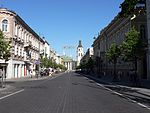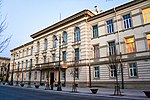
Vilnius is the capital of and largest city in Lithuania, and the second-most populous city in the Baltic states. As of January 2024, Vilnius' estimated population was 602,430, and the Vilnius urban area which extends beyond the city limits has an estimated population of 708,627.
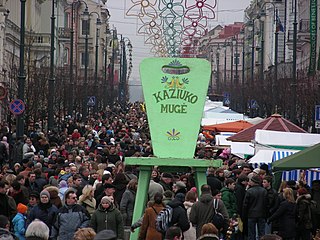
Kaziuko mugė or Saint Casimir's Fair is a large annual folk arts and crafts fair in Lithuania, dating to the beginning of the 17th century. The fair is traditionally held in city's markets and streets on the Sunday nearest to 4 March, the anniversary of Saint Casimir's death. In Lithuanian, Kaziukas is a diminutive of Casimir. Today, Saint Casimir's fair also features music, dance, theater performances; it attracts tens of thousands of visitors and many craftsmen from across Lithuania as well as from neighbouring countries such as Latvia, Russia, and Poland. In recent years, the fair has expanded into other cities in Lithuania, Belarus, Poland.
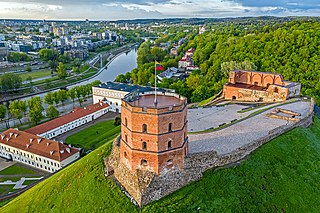
Gediminas' Tower is the remaining part of the Upper Castle on top of the Gediminas Hill in Vilnius, Lithuania. It has a viewing platform that offers scenic views of Vilnius Old Town and Vilnius Central Business District.
The city of Vilnius, the capital and largest city of Lithuania, has an extensive history starting from the Stone Age. Vilnius was the head of the Grand Duchy of Lithuania until 1795, even during the Polish–Lithuanian Commonwealth. The city has changed hands many times between Imperial and Soviet Russia, Napoleonic France, Imperial and Nazi Germany, Interwar Poland, and Lithuania. It was especially often the site of conflict after the end of World War I and during World War II. It officially became the capital of independent, modern-day Lithuania when the Soviet Union recognized the country's independence in August 1991.
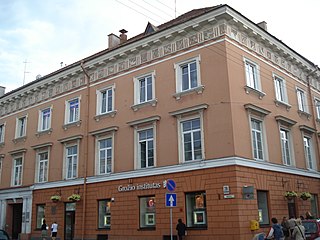
Tyzenhauz Palace is an 18th-century mansion located in the city of Vilnius, Lithuania.

The Old Town of Vilnius, one of the largest surviving medieval old towns in Northern Europe, has an area of 3.59 square kilometres. It encompasses 74 quarters, with 70 streets and lanes numbering 1487 buildings with a total floor area of 1,497,000 square meters. It was founded by the Lithuanian Grand Duke and King of Poland Jogaila in 1387 on the Magdeburg rights the oldest part of the Lithuanian capital of Vilnius, it had been developed over the course of many centuries, and has been shaped by the city's history and a constantly changing cultural influence. It is a place where some of Europe's greatest architectural styles—gothic, renaissance, baroque and neoclassical—stand side by side and complement each other. There are many Catholic, Lutheran and Orthodox churches, residential houses, cultural and architectural monuments, museums in the Old Town.

The Cathedral Basilica of St Stanislaus and St Ladislaus of Vilnius is the main Catholic cathedral in Lithuania. It is situated in Vilnius Old Town, just off Cathedral Square. Dedicated to the Christian saints Stanislaus and Ladislaus, the church is the heart of Catholic spiritual life in Lithuania.

The Cathedral Square in Vilnius is the main square of the Vilnius Old Town, right in front of the neo-classical Vilnius Cathedral. It is a key location in city's public life, situated as it is at the crossing of the city's main streets and reflecting the city's diversity. Regularly held at this site are fairs and gatherings of townspeople, military parades, religious and official public events, attractions and large concerts, New Year’s salutes and exhibitions. It is not merely the most lively and important location in the city, but is also one of the most significant and widely known symbols of Lithuania.
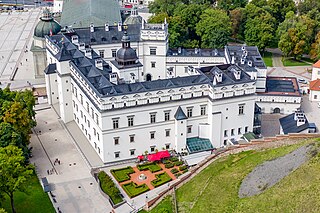
The Palace of the Grand Dukes of Lithuania is a palace in Vilnius, Lithuania. It was originally constructed in the 15th century for the rulers of the Grand Duchy of Lithuania and the future Kings of Poland. The palace, located in the lower castle of Vilnius, evolved over the years and prospered during the 16th and mid-17th centuries. For four centuries the palace was the political, administrative and cultural centre of the Polish–Lithuanian Commonwealth. It was demolished in 1801.

The Vilnius Castle Complex is a group of cultural, and historic structures on the left bank of the Neris River, near its confluence with the Vilnia River, in Vilnius, Lithuania. The buildings, which evolved between the 10th and 18th centuries, were one of Lithuania's major defensive structures.
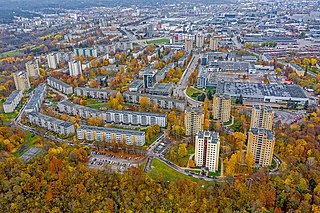
Žirmūnai is the most populous administrative division (elderate) in Vilnius. It is also a neighbourhood in the Lithuanian capital city Vilnius, encompassing the city district of the same name, built in the 1960s.
The national symbols of Lithuania are used in Lithuania and abroad to represent the country and its people, history, culture, and nature. These symbols are seen in official capacities, such as flags, coats of arms, postage stamps, and currency, and in URLs. They appear less formally as recurring themes in literature, art and folk art, heraldry, monuments, clothing, personal decoration, and as the names of parks, bridges, streets, and clubs. The less formal manifestations may be classified as national emblems.

Tuskulėnai Manor is a neoclassical manor in Žirmūnai elderate of Vilnius, Lithuania. It is best known as burial grounds of people executed by the KGB in 1944–1947. After Lithuania regained independence in 1990, the manor was reconstructed and the park was transformed into a memorial to the victims of Soviet repressions. It is administered by the Lithuanian Genocide and Resistance Research Center.

Lukiškės Square is the largest square (about 4 hectares in Vilnius, Lithuania, located in the center of the city. A major street in Vilnius, Gediminas Avenue, passes by the southern border of the square. It is surrounded by many public buildings, including the Ministry of Finance, Ministry of Foreign Affairs, Court of Appeal, Academy of Music and Theatre, Church of Saints Philip and James, and the Dominican monastery with the former St. Jacob Hospital.
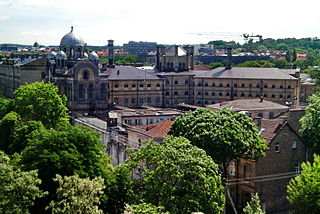
Lukiškės Prison was a prison in the center of Vilnius, Lithuania, near the Lukiškės Square.
The following is a timeline of the history of the city of Vilnius, Lithuania.
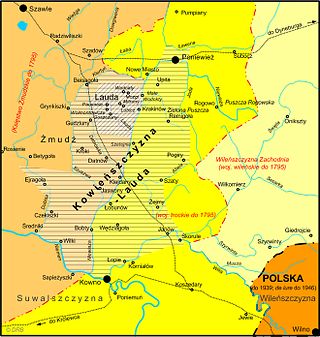
Liauda, also known as Kaunas Region, is a historical region centred around Liaudė river on the north from city of Kaunas, and located between Nemunas, Neris and Dubysa rivers. The region is located within modern borders of Lithuania. It borders historical regions of Samogitia, Suvalkija and Vilnius. Its area is approximately 6500 km2.

The 1st Infantry Regiment, later the 1st Infantry Regiment of the Lithuanian Grand Duke Gediminas was an infantry regiment that served in the Lithuanian Army during the Interwar period.

Gediminas' Cap was the most important regalia of the Lithuanian monarchs who ruled the Grand Duchy of Lithuania until the Union of Lublin in 1569. During the inaugurations of Lithuanian monarchs, Gediminas' Cap was placed on the monarch's heads by the Bishop of Vilnius in Vilnius Cathedral.



